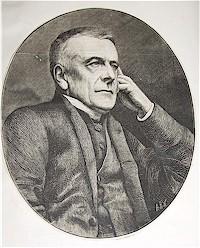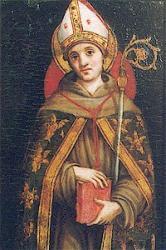Planning worship?
Check out our sister site, ZeteoSearch.org,
for 20+ additional resources related to your search.
- |
User Links
Person Results
Richard Redhead

1820 - 1901 Composer of "ST. PRISCA" in The Cyber Hymnal Richard Redhead (b. Harrow, Middlesex, England, 1820; d. Hellingley, Sussex, England, 1901) was a chorister at Magdalen College, Oxford. At age nineteen he was invited to become organist at Margaret Chapel (later All Saints Church), London. Greatly influencing the musical tradition of the church, he remained in that position for twenty-five years as organist and an excellent trainer of the boys' choirs. Redhead and the church's rector, Frederick Oakeley, were strongly committed to the Oxford Movement, which favored the introduction of Roman elements into Anglican worship. Together they produced the first Anglican plainsong psalter, Laudes Diurnae (1843). Redhead spent the latter part of his career as organist at St. Mary Magdalene Church in Paddington (1864-1894).
Bert Polman
Richard Redhead
Frederick Oakeley

1802 - 1880 Translator (from Latin) of "In the Lord's Atoning Grief" in The Cyber Hymnal Frederic Oakeley graduated M.A. at Oxford, and took Orders in the Church of England. He became Prebendary of Lichfield Cathedral, preacher at Whitehall, and incumbent of Margaret Chapel, London. He was active in the "Oxford Movement," and in 1845, called attention to his views for the purpose of seeing if he could continue to hold an Oxford degree, with so great a change in his opinions. The question was tried, and he was perpetually suspended unless he retracted. He then resigned his positions in the Church of England, and entered the Church of Rome, in which he became a Priest, and Canon of the diocese of Westminster. His publications are numerous, and some of them have considerable value.
--Annotations of the Hymnal, Charles Hutchins, M.A., 1872
=================
Oakeley, Frederick, D.D., youngest son of Sir Charles Oakeley, Bart., sometime Governor of Madras, was born at Shrewsbury, Sept. 5, 1802, and educated at Christ Church, Oxford (B.A. 1824). In 1825 he gained a University prize for a Latin Essay; and in 1827 he was elected a Fellow of Balliol. Taking Holy Orders, he was a Prebendary of Lichfield Cathedral, 1832; Preacher at Whitehall, 1837; and Minister of Margaret Chapel, Margaret Street, London, 1839. In 1845 he resigned all his appointments in the Church of England, and was received into the Roman Communion. Subsequently he became a Canon of the Pro-Cathedral in the Roman Catholic ecclesiastical district of Westminster. He died January 29, 1880. Miller (Singers and Songs of the Church, 1869, p. 497), writing from information supplied to him by Canon Oakeley, says:—
”He traces the beginning of his change of view to the lectures of Dr. Charles Lloyd, Regius Professor, delivered at Oxford about the year 1827, on the 'History and Structure of the Anglican Prayer Book.' About that time a great demand arose at Oxford for Missals and Breviaries, and Canon Oakeley, sympathising with the movement, co-operated with the London booksellers in meeting that demand.....He promoted the [Oxford] movement, and continued to move with it till, in 1845, he thought it right to draw attention to his views, to gee if he could continue to hold an Oxford degree in conjunction with so great a change in opinion. The question having been raised, proceedings were taken against him in the Court of Arches, and a sentence given that he was perpetually suspended unless he retracted. He then resigned his Prebendal stall at Lichfield, and went over to the Church of Rome."
Canon Oakeley's poetical works included:—
(1) Devotions Commemorative of the Most Adorable Passion of Our Lord and Saviour Jesus Christ, 1842; (2) The Catholic Florist; (3) The Youthful Martyrs of Rome, a Christian Drama, 1856; (4) Lyra Liturgica; Reflections in Verse for Holy Days and Seasons, 1865.
Canon Oakeley also published several prose works, including a translation of J. M. Horst's Paradise of the Christian Soul, London, Burns, 1850. He is widely known through his translation of the “Adeste fideles.” Several of his original hymns are also in Roman Catholic collections.
--John Julian, Dictionary of Hymnology (1907)
Frederick Oakeley
St. Bonaventure

1217 - 1274 Person Name: Bonaventura, 1221-1274 Author (attributed to) of "In the Lord's Atoning Grief" in The Cyber Hymnal Bonaventura, Saint and Cardinal, commonly called "Doctor Seraphicus," was born of pious and well-to-do parents at Bagnera, in Tuscany, 1221. His father's name was John, of Fidenza, and he was baptized in his father's name of John. It is said that his mother, when her boy of four years old was "sick unto death," made a vow that, if he recovered, he should become a member of the Order of St. Francis, and that, his recovery taking place immediately thereupon, she exclaimed, "O Bonaventura!" (“O what good luck") the name adopted by the son when he entered the Franciscan Order in 1242.
He was sent by his Order as a student to the University of Paris probably in or about A.D. 1242, and became a Professor of Theology there in 1245. In 1256, at the age of thirty-five years, and thirteen years after his profession as a monk, he was, in his absence, unanimously elected General of his Order by a Chapter held at Rome in the presence of the then Pope, Alexander IV. His election proved a happy one for the Franciscans, whose Order was in a critical condition, threatened with a schism, and tainted with heresy. In 1267 he was offered the Archbishopric of York by Pope Clement IV., but declined it, on the ground that any further addition to the long list of Italian dignitaries, who were being forced upon the Church of England at that time against its will, would cause fresh strife, and end in his expulsion. Upon the death of Clement in the following year, it is said (with what amount of truth authorities differ) that he declined the Papacy itself, though strongly urged to accept it, in order to put an end to the dissension between the French and Italian Cardinals, which kept the chair of St. Peter vacant for more than two years. When at last the College of Cardinals had delegated to six of their number the power of filling up the vacancy, and these delegates, possibly by Bonaventura's advice, had elected Theobald, Archdeacon of Liege, under the title of Gregory X., the new Pope very soon after his election made Bonaventura a Cardinal, so sorely against the will of the latter, that he fled to Paris in order to escape from the fresh responsibilities that such a position involved, and was only induced to return for investiture by the positive orders of the Pope to that effect. When he reached Rome, having received his cardinal's hat on the way, he was (1273) consecrated Bishop of Alba, one of the six suffragans of Rome.
He did not long enjoy his new honours. In 1274 Gregory X. assembled a great (Ecumenical Council at Lyons, at which 500 bishops, 70 abbots, and at least 1000 dignified clergy were present. The two leading churchmen of the age, Thomas Aquinas and Bonaventura, were summoned to attend, the former to die on his road thither, the latter before its proceedings closed, in which he had taken part. Bonaventura was taken ill on July 6th, and died on July 14th, 1274. He was buried in the Convent of the Minorites at Lyons in the presence of the Pope and all the Council.
When we turn from the facts of Bonaventura's life to discuss his literary qualities and achievements, the same remark forces itself upon us, that has to be made about so many of the great mediaeval writers, whose compositions consist both of prose and poetry, viz., that the former very far outweigh the latter in quantity, as well as in importance. His contributions to Latin hymnology are few and far between; and, though generally good, are scarcely, with one exception, in the front rank of such compositions. Of his style, as a hymn-writer, Archbishop Trench, who is not given" to exaggerated praise, says, "His Latin poetry is good, but does not call for any especial criticism" (Sacred Latin Poetry, p. 145); while Dean Milman places his "Hymn to the Cross" as only inferior in melody to the "Stabat Mater" of Jacopone da Todi, and the "Dies Irae" of Thomas of Celano. But, indeed, beyond the beautiful "Recordare sanctae crucis," it is more than doubtful what hymns can be certainly attributed to Bonaventura. Trench gives us in his Sacred Latin Poetry two others, very beauti¬ful in their very different styles, “Quara despectus, quam dejectus," and "Quantum hamum caritas tibi praesentavit," both of which he extracts from what is the best edition of our author's collected works, Bonaventurae Opp., Lugduni, 1668. It is, however, by no means certain that either was really his work. Daniel gives us only the "Recordare Sanctae Crucis" as cer¬tainly written by Bonaventura, besides a hymn to the Virgin, founded on the “Te Deum," ii. 293, com-mencing " Te Matrem Dei Laudamus." Mone attributes to him also the "In passione Domini, qua datur salus homini" (q.v.), and gives a "Planctus Bonaventurae de Christo," beginning "0 Crux, frutex salvificus," which, however, he says is not included in the poems of Bonaventura as given in his collected works (i. 152); a version of a hymn by him on the “Crown of Mary" (ii. 172), an "Officium Compassionis" on the Blessed Virgin (ii. 139), and a long "Psalter of the Virgin " (ii. 233), which, however, Trench doubts his having written. An edition published by a Dominican editor in the 15th century, of St. Bernard's "Oratio ad Christum in crucem pendentem," according to Mone, attributes part of it, “Salve, salve, Jesu pie," to Bonaventura and not to Bernard, and calls it " Orationes Bonaventurae," &c. This "statement of the editor," Mone adds, "is not to be overlooked." Several of his hymns were in use in public worship, and the continual copying of them by different hands, which this involved, has rendered it very difficult, if not impossible, to ascertain always their correct texts. Very few have been translated into English.
[Rev. Digby S. Wrangham, M.A.]
-- John Julian, Dictionary of Hymnology (1907)
===============
Bonaventura, St., p. 162, ii. In Canon Oakeley's Devotions Commemorative of The Most Adorable Passion of Our Lord Jesus Christ, &c, 1812, there are several translations of hymns from St. Bonaventura's published works.
--John Julian, Dictionary of Hymnology, Appendix, Part II (1907)
St. Bonaventure


 My Starred Hymns
My Starred Hymns


